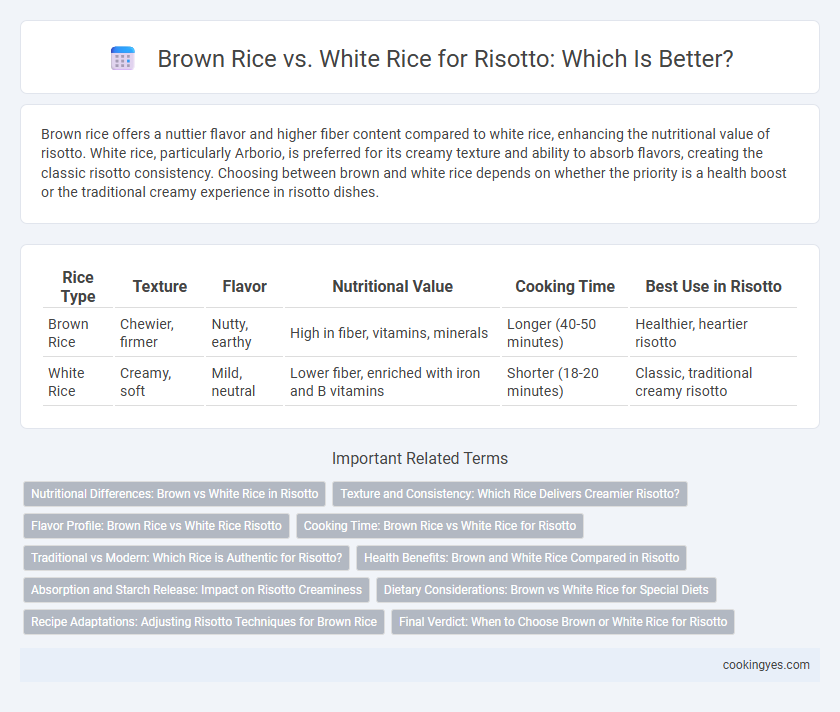Brown rice offers a nuttier flavor and higher fiber content compared to white rice, enhancing the nutritional value of risotto. White rice, particularly Arborio, is preferred for its creamy texture and ability to absorb flavors, creating the classic risotto consistency. Choosing between brown and white rice depends on whether the priority is a health boost or the traditional creamy experience in risotto dishes.
Table of Comparison
| Rice Type | Texture | Flavor | Nutritional Value | Cooking Time | Best Use in Risotto |
|---|---|---|---|---|---|
| Brown Rice | Chewier, firmer | Nutty, earthy | High in fiber, vitamins, minerals | Longer (40-50 minutes) | Healthier, heartier risotto |
| White Rice | Creamy, soft | Mild, neutral | Lower fiber, enriched with iron and B vitamins | Shorter (18-20 minutes) | Classic, traditional creamy risotto |
Nutritional Differences: Brown vs White Rice in Risotto
Brown rice in risotto retains the bran and germ, providing higher fiber, vitamins B and E, and essential minerals like magnesium compared to white rice. White rice undergoes milling that removes these nutrient-rich layers, resulting in faster cooking but lower nutritional content. The higher fiber in brown rice supports digestion and blood sugar regulation, making it a healthier choice for risotto without compromising on creaminess when cooked properly.
Texture and Consistency: Which Rice Delivers Creamier Risotto?
Arborio rice, a polished white rice, is preferred for risotto due to its high amylopectin starch content, which creates a creamy and smooth consistency. Brown rice, retaining its bran layer, offers a nuttier flavor but results in a firmer, chewier texture that lacks the traditional creaminess. For achieving the classic velvety texture of risotto, white Arborio rice delivers a superior creamy consistency compared to brown rice.
Flavor Profile: Brown Rice vs White Rice Risotto
Brown rice risotto offers a nuttier, earthier flavor with a chewier texture that complements hearty, rustic dishes, while white rice risotto delivers a creamier, more delicate taste and smooth consistency ideal for traditional, refined recipes. The bran layer in brown rice retains more fiber and nutrients, influencing its robust flavor and slightly firmer bite compared to the polished, starchy grain of white rice. Choosing between brown and white rice in risotto depends on the desired balance of flavor complexity and texture softness in the final dish.
Cooking Time: Brown Rice vs White Rice for Risotto
Brown rice requires a longer cooking time than white rice when making risotto, typically around 40 to 50 minutes compared to the 18 to 25 minutes needed for white Arborio rice. The higher fiber content in brown rice slows water absorption, demanding extended simmering for a creamy texture. Choosing white rice like Carnaroli or Vialone Nano ensures traditional risotto consistency with faster preparation.
Traditional vs Modern: Which Rice is Authentic for Risotto?
Arborio rice, traditionally used in risotto, offers a creamy texture and firm bite due to its high amylopectin content, essential for authentic Italian risotto. Brown rice, considered a modern variation, introduces a nuttier flavor and higher fiber but lacks the same starch release, resulting in a less creamy consistency. Culinary experts prioritize Arborio as the authentic choice for risotto, preserving the dish's signature texture and taste.
Health Benefits: Brown and White Rice Compared in Risotto
Brown rice risotto contains higher amounts of fiber, vitamins B and E, and essential minerals like magnesium and zinc compared to its white rice counterpart, promoting better digestion and heart health. The presence of bran and germ in brown rice enhances antioxidant levels and aids in blood sugar regulation, making it a healthier option for those monitoring glucose levels. White rice risotto, while having a softer texture, offers quicker digestion but lacks the nutritional density found in brown rice, which can be critical for long-term wellness.
Absorption and Starch Release: Impact on Risotto Creaminess
Brown rice absorbs liquid more slowly than white Arborio rice due to its intact bran layer, resulting in a less creamy texture in risotto. White Arborio rice releases more starch during cooking, creating the characteristic creamy consistency prized in traditional risotto dishes. The higher amylopectin content in white rice enhances starch release, making it ideal for achieving a rich and velvety risotto texture.
Dietary Considerations: Brown vs White Rice for Special Diets
Brown rice offers higher fiber content and more essential nutrients like magnesium and antioxidants, making it suitable for those on high-fiber or whole-food diets. White rice, being more easily digestible and lower in fiber, is often preferred for individuals with sensitive digestion or specific low-fiber dietary needs. For risotto, choosing brown rice can support blood sugar control and satiety, while white rice provides a creamier texture ideal for traditional preparations.
Recipe Adaptations: Adjusting Risotto Techniques for Brown Rice
Brown rice requires longer cooking times and more liquid absorption than white rice when making risotto, demanding adjustments in heat and stirring frequency. Its higher fiber content and nutty flavor enhance texture but necessitate gradual broth addition and extended simmering to achieve creaminess. Using toasted brown rice and incorporating pre-soaked grains can significantly improve risotto consistency and depth of flavor.
Final Verdict: When to Choose Brown or White Rice for Risotto
White rice, particularly Arborio, is ideal for risotto due to its high starch content, creating the classic creamy texture and rich flavor. Brown rice offers a nuttier taste and higher fiber but requires longer cooking time and yields a chewier consistency, which changes the traditional risotto experience. Choose white rice for authentic creaminess and brown rice for a healthier, more textured alternative when making risotto.
Brown vs White for risotto Infographic

 cookingyes.com
cookingyes.com